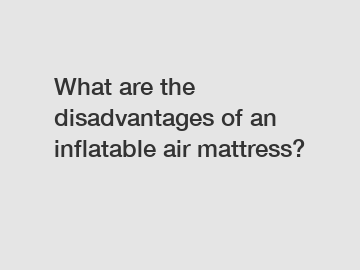What are the disadvantages of an inflatable air mattress?
What are the disadvantages of an inflatable air mattress?
An inflatable air mattress, though widely used for its portability and convenience, has its fair share of disadvantages. These drawbacks range from discomfort and potential health issues to a shorter lifespan and maintenance challenges. In this article, we will delve into the origins of these downsides, analyze the supporting evidence, and discuss their significance and impact.
Comfort seems to be the first disadvantage of an inflatable air mattress. Unlike traditional mattresses, which offer a stable and firm surface, air mattresses can be bouncy and provide little support, leading to a less restful sleep. The lack of proper spinal alignment and cushioning can result in morning stiffness and back pain. Furthermore, air mattresses are susceptible to deflation during the night, causing discomfort and disrupting sleep. This discomfort arises due to the reliance on air as the main support structure, which can easily be compressed and deflated with movement or weight shifts.

The health risks associated with inflatable air mattresses are another significant disadvantage. Air mattresses, especially those made of PVC materials, can emit harmful volatile organic compounds (VOCs) that affect indoor air quality. Prolonged exposure to these chemicals may result in respiratory issues, allergies, or even potential long-term health problems. Additionally, the lack of ventilation within the mattress can promote the growth of molds and mildew, exacerbating allergies and asthma symptoms for susceptible individuals. These health risks indicate that using an inflatable air mattress may not be the best choice for individuals with existing respiratory conditions or sensitivities.
The lifespan and maintenance challenges of inflatable air mattresses also contribute to their drawbacks. While traditional mattresses can last for several years, air mattresses tend to have a significantly shorter lifespan. The constant inflation and deflation cycles, as well as potential punctures or leaks, can reduce their durability. Repairing an air mattress can be quite cumbersome, as locating the source of a leak can be time-consuming and patching it may not always yield long-term success. Furthermore, the need for an air pump and the risk of power outages can render an inflatable mattress useless, disrupting one's sleeping arrangements at inconvenient times.
The significance and impact of these disadvantages should not be underestimated. A good night's sleep is vital for overall health and well-being, and the discomfort caused by an inflatable air mattress can have negative consequences on one's physical and mental state. The potential health risks associated with VOC emissions and mold growth add further concern, particularly for those with respiratory conditions or allergies. The shorter lifespan and maintenance challenges can also result in additional expenses and inconvenience. Considering these factors, individuals should weigh the convenience and portability of inflatable air mattresses against their drawbacks before making a final purchasing decision.
In conclusion, the disadvantages of an inflatable air mattress include discomfort, potential health risks, shorter lifespan, and maintenance challenges. These downsides are rooted in the lack of support and instability offered by air mattresses, the emission of harmful VOCs, and the susceptibility to punctures and leaks. Understanding these disadvantages is crucial for individuals seeking a comfortable and long-lasting sleeping solution. By considering the trade-offs between convenience and drawbacks, individuals can make an informed decision that aligns with their needs and preferences.
For more information, please visit Dual Chamber Air Mattress, Replacement Air Bed Chambers, Mattress with Air Chambers.


